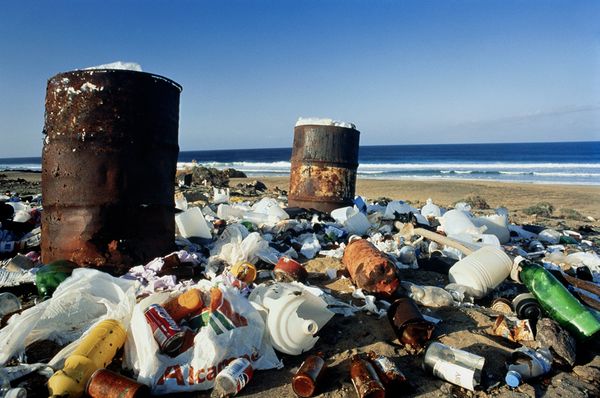
"Many people have heard of the Great Pacific Garbage Patch," said Kara Lavender Law, an oceanographer at the Sea Education Association in Woods Hole, Massachusetts.
"But this issue has essentially been ignored in the Atlantic."
The newly described garbage patch sits hundreds of miles off the North American coast. Although its east-west span is unknown, the patch covers a region between 22 and 38 degrees north latitude - roughly the distance from Cuba to Virginia.
As with the Pacific garbage patch, plastic can circulate in this part of the Atlantic Ocean for years, posing health risks to fish, seabirds, and other marine animals that accidentally eat the litter.
Elusive Ocean Trash
To get a clear picture of the Atlantic garbage patch, Law drew on 22 years of data collected by students participating in her association's SEA Semester academic program.
As part of this program, more than 7,000 students have gone on research cruises, deploying thousands of fine-meshed plankton nets to meticulously catalog bits of plastic enmeshed with the drifting plants and animals.
Tiny pieces of trash, each less than a tenth the weight of a paper clip, make up most of the debris, Law said February 23 at the American Geophysical Union's 2010 Ocean Sciences meeting in Portland, Oregon.
In some places the students found more than 200,000 bits of trash per square kilometer (520,000 bits per square mile). The vast majority of these fragments come from consumer products that were blown out of open landfills or were tossed out by litterbugs.
Similar surface trawls in the Great Pacific Garbage Patch have found as many as 750,000 bits of plastic per square kilometer (1.9 million bits per square mile), noted marine chemist Giora Proskurowski, also with the Sea Education Association.
But that's only a portion of the total, he said, because waves often carry plastic as deep as 65 feet (20 meters) below the surface.
Still, it's not as if there's so much plastic you can walk across the ocean surface, he said. Proskurowski said he has seen the floating Pacific plastic only once, when the sea was glassy calm.
"When I looked off the deck of the ship, I saw hundreds and hundreds of little tiny pieces," he said. "When the wind picked up, I could no longer see it."
Trash Escaping to Hawaii
Using floating satellite tags called drifters, Nikolai Maximenko of the University of Hawaii in Honolulu has tracked the currents that carry trash to the Atlantic and Pacific garbage patches.
In the Great Pacific Garbage Patch, drifter studies have indicated that currents occasionally change, allowing floating materials to escape the vortex.
When that happens, "they never go to the California beach, but they do go to the Hawaiian Islands," Maximenko said. Pieces that don't wind up in Hawaii eventually cycle back into the Pacific garbage patch.
Drifters deployed in the Atlantic show a similar system of currents in the new found garbage patch, the researchers said, which means pieces could be escaping when those currents shift.
Overall, the Sea Education Association's Proskurowski said, finding plastic so far out in either ocean is sobering, because "it forces us into physical confrontation with the human impact on the environment."



I suspect the majority of this is NOT coming from land fills but from cargo ships, cruise lines and other corporate scum and government(s) that find it cheaper to dispose of waste at sea. This is more than likely the tip of the iceberg. Who knows what else is being dumped in our oceans, medical waste, hazardous materials, radioactive waste, sewage. It's no wonder mother earth is pissed off, ready to shake the fleas from her back.